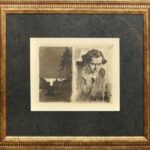
Dobužinskis Mstislavas
Coming from an old Lithuanian noble family, M. Dobužinskis studied at the Vilnius Gymnasium, from 1885 to 1887 – at the Drawing School of the St. Petersburg Society for the Promotion of Art. From 1895 to 1899 he studied at the Faculty of Law of St. Petersburg University, from 1899 to 1901 – in Munich. From 1903 he participated in the activities of the “World of Art” society. This group had an influence on the further work of M. Dobužinskis. From 1902 he participated as a painter in all Russian artists’ unions and in the art exhibitions of the “World of Art” group.
From 1907 M. Dobužinskis began to express himself as a set designer, worked as a decorator in St. Petersburg and Moscow theaters. From 1918 – a teacher at the A. Stiglitz School of Technical Drawing and the St. Petersburg Academy of Arts, in 1922 he became a professor.
In 1923, M. Dobužinskis arrived in Kaunas to participate in an exhibition organized by the Plastics Section of the Lithuanian Society of Artists. In 1925, he arrived at the invitation of the State Theater to create decorations for Pyotr Tchaikovsky’s opera “The Queen of Spades”. After some time, he was granted Lithuanian citizenship. He spent several years abroad (creating decorations, organizing exhibitions), and in 1929 he returned to Kaunas.
In 1929 – 1930, he headed the graphic and decorative painting studios of the Kaunas Art School. In 1930, he founded a private art studio on Maironio Street, which operated until 1933.
From 1931, he worked as a set designer at the State Theater. In 1933, he participated in the creation of the Lithuanian coat of arms, flag, orders, and postage stamps. He actively participated in the protection and restoration of ancient monuments as a member of commissions. On November 23, 1938, the niche of Vytautas the Great, decorated by him, was opened in the War Museum.
In 1939, he went to London to prepare an exhibition of his works. There, he was caught up in the Second World War. For some time, the artist lived in Paris, later in the USA. He never returned to Lithuania. He died in New York on November 20, 1957. His remains are buried in the Paris cemetery. He designed and illustrated books (H. K. Andersen’s “Pigtails”, 1922; F. Dostoevsky’s “White Nights”, 1923; J. Oleša’s “Three Little Pigs”, 1928; B. Sruoga’s “Song of Gediminas”, 1938), created bookplates, posters, and decorations for twelve performances of the Moscow Art Theater (I. Turgenev’s “A Month in the Country”, 1909), ballets of S. Diaghilev’s troupe in Paris (1914), and designed 38 productions of the Kaunas State Theater (P. Tchaikovsky’s “The Queen of Spades”, 1925; Š. Gunas’ “Faust”, 1931; V. A. Mozart’s “Don Juan”, 1933; J. Karnavičius’ “Radvila Perkūnas”, 1937). The State M.K.Čiurlionis Museum in Kaunas preserves Lithuanian playing cards designed by Dobužinskis and produced in the “Spindulis” printing house in 1933.
He created landscapes and portraits of Kaunas, Vilnius, St. Petersburg, and other cities with a unique style. He wrote studies “On the Vytautas Mark” (1932), “Vytis: Features of Historical Variants of the Coat of Arms of the Grand Duchy of Lithuania” (1933). In 1938, he published articles about the Lithuanian national flag in “Romuva”.
M. Dobužinskis’ interior architectural decoration is noteworthy – in the Presidential Palace, Vytautas the Great Gymnasium in Klaipėda, and the War Museum. Over 1,000 of his works are preserved in the Theater and Music Museum, the rest in the Vilnius and Kaunas Art Museums.



